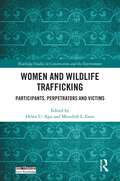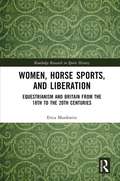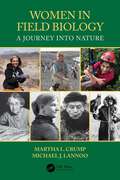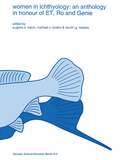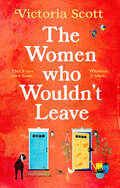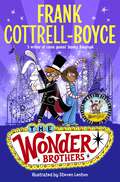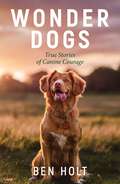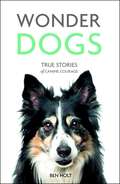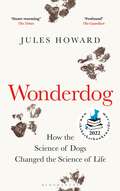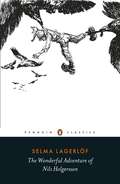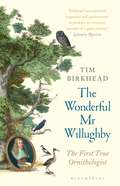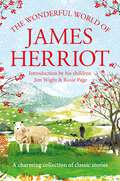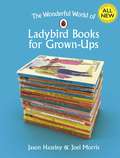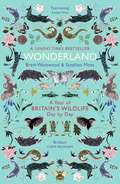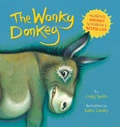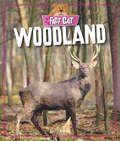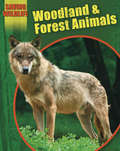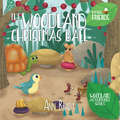- Table View
- List View
Women and Wildlife Trafficking: Participants, Perpetrators and Victims (Routledge Studies in Conservation and the Environment)
by Helen U. AguThis volume examines women and wildlife trafficking via a bespoke collection of narratives, case studies and theoretical syntheses from diverse voices and disciplines. Wildlife trafficking has been documented in over one hundred and twenty countries around the world. While species extinction and animal abuse are major problems, wildlife trafficking is also associated with corruption, national insecurity, spread of zoonotic disease, undercutting sustainable development investments and erosion of cultural resources among others. The role of women in wildlife trafficking has remained woefully under-addressed, with scientists and policymakers failing to consider the important causes and consequences of the gendered dimensions of wildlife trafficking. Although the roles of women in wildlife trafficking are mostly unknown, they are not unknowable. This volume helps fill this lacuna by examining the roles and experiences of women with case studies drawn from across the world, including Mexico, Cameroon, the Central African Republic, South Africa and Norway. Women can be wildlife trafficking preventors, perpetrators, and pawns; their roles in both facilitating wildlife trafficking are considered from both a supply and a demand viewpoint. The first half of the book assesses the state of science, offering four different perspectives on how women and wildlife trafficking can be studied or evaluated. The second half of the book profiles diverse case studies from around the world, offering context-specific insight about on-the-ground activities associated with women and wildlife trafficking. This book will be of great interest to students and scholars of wildlife crime, conservation, gender studies, green criminology and environmental law. It will also be of interest to NGOs and policymakers working to improve efficacy of efforts targeting wildlife crime, the illegal wildlife trade, and conservation more broadly.
Women and Wildlife Trafficking: Participants, Perpetrators and Victims (Routledge Studies in Conservation and the Environment)
by Helen U. Agu Meredith L. GoreThis volume examines women and wildlife trafficking via a bespoke collection of narratives, case studies and theoretical syntheses from diverse voices and disciplines. Wildlife trafficking has been documented in over one hundred and twenty countries around the world. While species extinction and animal abuse are major problems, wildlife trafficking is also associated with corruption, national insecurity, spread of zoonotic disease, undercutting sustainable development investments and erosion of cultural resources among others. The role of women in wildlife trafficking has remained woefully under-addressed, with scientists and policymakers failing to consider the important causes and consequences of the gendered dimensions of wildlife trafficking. Although the roles of women in wildlife trafficking are mostly unknown, they are not unknowable. This volume helps fill this lacuna by examining the roles and experiences of women with case studies drawn from across the world, including Mexico, Cameroon, the Central African Republic, South Africa and Norway. Women can be wildlife trafficking preventors, perpetrators, and pawns; their roles in both facilitating wildlife trafficking are considered from both a supply and a demand viewpoint. The first half of the book assesses the state of science, offering four different perspectives on how women and wildlife trafficking can be studied or evaluated. The second half of the book profiles diverse case studies from around the world, offering context-specific insight about on-the-ground activities associated with women and wildlife trafficking. This book will be of great interest to students and scholars of wildlife crime, conservation, gender studies, green criminology and environmental law. It will also be of interest to NGOs and policymakers working to improve efficacy of efforts targeting wildlife crime, the illegal wildlife trade, and conservation more broadly.
Women, Horse Sports and Liberation: Equestrianism and Britain from the 18th to the 20th Centuries (Routledge Research in Sports History)
by Erica MunkwitzThis book is the first, full-length scholarly examination of British women’s involvement in equestrianism from the eighteenth through the twentieth centuries, as well as the corresponding transformations of gender, class, sport, and national identity in Britain and its Empire. It argues that women’s participation in horse sports transcended limitations of class and gender in Britain and highlights the democratic ethos that allowed anyone skilled enough to ride and hunt – from chimney-sweep to courtesan. Furthermore, women’s involvement in equestrianism reshaped ideals of race and reinforced imperial ideology at the zenith of the British Empire. Here, British women abandoned the sidesaddle – which they had been riding in for almost half a millennium – to ride astride like men, thus gaining complete equality on horseback. Yet female equestrians did not seek further emancipation in the form of political rights. This paradox – of achieving equality through sport but not through politics – shows how liberating sport was for women into the twentieth century. It brings into question what “emancipation” meant in practice to women in Britain from the eighteenth through twentieth centuries. This is fascinating reading for scholars of sports history, women's history, British history, and imperial history, as well as those interested in the broader social, gendered, and political histories of the nineteenth and twentieth centuries, and for all equestrian enthusiasts.
Women, Horse Sports and Liberation: Equestrianism and Britain from the 18th to the 20th Centuries (Routledge Research in Sports History)
by Erica MunkwitzThis book is the first, full-length scholarly examination of British women’s involvement in equestrianism from the eighteenth through the twentieth centuries, as well as the corresponding transformations of gender, class, sport, and national identity in Britain and its Empire. It argues that women’s participation in horse sports transcended limitations of class and gender in Britain and highlights the democratic ethos that allowed anyone skilled enough to ride and hunt – from chimney-sweep to courtesan. Furthermore, women’s involvement in equestrianism reshaped ideals of race and reinforced imperial ideology at the zenith of the British Empire. Here, British women abandoned the sidesaddle – which they had been riding in for almost half a millennium – to ride astride like men, thus gaining complete equality on horseback. Yet female equestrians did not seek further emancipation in the form of political rights. This paradox – of achieving equality through sport but not through politics – shows how liberating sport was for women into the twentieth century. It brings into question what “emancipation” meant in practice to women in Britain from the eighteenth through twentieth centuries. This is fascinating reading for scholars of sports history, women's history, British history, and imperial history, as well as those interested in the broader social, gendered, and political histories of the nineteenth and twentieth centuries, and for all equestrian enthusiasts.
Women in Field Biology: A Journey into Nature
by Martha L. Crump Michael J. LannooWomen are contributing to disciplines once the sole domain of men. Field biology has been no different. The history of women field biologists, embedded in a history largely made and recorded by men, has never been written. Compilations of biographies have been assembled, but the narrative—their story—has never been told. In part, this is because many expressed their passion for nature as writers, artists, collectors, and educators during eras when women were excluded from the male-centric world of natural history and science. The history of women field biologists is intertwined with men’s changing views of female intellect and with increasing educational opportunities available to women. Given the preponderance of today’s professional female ecologists, animal behaviorists, systematists, conservation biologists, wildlife biologists, restoration ecologists, and natural historians, it is time to tell this story—the challenges and hardships they faced and still face, and the prominent role they have played and increasingly play in understanding our natural world. For a broader perspective, we profile selected European women field biologists, but our primary focus is the journey of women field biologists in North America. Each woman highlighted here followed a unique path. For some, personal wealth facilitated their work; some worked alongside their husbands. Many served as invisible assistants to men, receiving little or no recognition. Others were mavericks who carried out pioneering studies and whose published works are still read and valued today. All served as inspiration and proved to the women who would follow that women are as capable as men at studying nature in nature. Their legacy lives on today. The 75 female field biologists interviewed for this book are further testament that women have the intellect, stamina, and passion for fieldwork.
Women in Field Biology: A Journey into Nature
by Martha L. Crump Michael J. LannooWomen are contributing to disciplines once the sole domain of men. Field biology has been no different. The history of women field biologists, embedded in a history largely made and recorded by men, has never been written. Compilations of biographies have been assembled, but the narrative—their story—has never been told. In part, this is because many expressed their passion for nature as writers, artists, collectors, and educators during eras when women were excluded from the male-centric world of natural history and science. The history of women field biologists is intertwined with men’s changing views of female intellect and with increasing educational opportunities available to women. Given the preponderance of today’s professional female ecologists, animal behaviorists, systematists, conservation biologists, wildlife biologists, restoration ecologists, and natural historians, it is time to tell this story—the challenges and hardships they faced and still face, and the prominent role they have played and increasingly play in understanding our natural world. For a broader perspective, we profile selected European women field biologists, but our primary focus is the journey of women field biologists in North America. Each woman highlighted here followed a unique path. For some, personal wealth facilitated their work; some worked alongside their husbands. Many served as invisible assistants to men, receiving little or no recognition. Others were mavericks who carried out pioneering studies and whose published works are still read and valued today. All served as inspiration and proved to the women who would follow that women are as capable as men at studying nature in nature. Their legacy lives on today. The 75 female field biologists interviewed for this book are further testament that women have the intellect, stamina, and passion for fieldwork.
Women in ichthyology: an anthology in honour of ET, Ro and Genie (Developments in Environmental Biology of Fishes #15)
by E. K. Balon Michael N. Bruton David L. G. NoakesThis special volume is dedicated to the contributions of women ichthyologists. Three colleagues were selected to represent all women ichthyologists, Ethelwynn Trewavas (ET), Rosemary Lowe-McConnell (Ro) and Eugenie Clark (Genie). All have had distinguished professional careers and have contributed in their own ways to their science. The career of each is highlighted by a personal interview with one of the editors of the volume, a bibliography of their lifetime publications, and a biography of their careers. Questions of historical inequities and current controversies in the treatment of women ichthyologists by their peers are raised and addressed by the women themselves. The personal and professional influences of these three women, and other women ichthyologists, are highlighted. A survey article by Pat Brown brings a number of women ichthyologists to the attention of a broader audience, and points the way for a more comprehensive historical consideration of the accomplishments and contributions of women ichthyologists. The volume continues with 16 solicited and contributed papers. ET's studies of taxonomy and life history are echoed in papers on the taxonomy and systematics of marine angelfishes, and of freshwater bitterlings, a review of reproduction in the North Atlantic ichthyofauna, and a comparison of reproductive styles and systematics of African minnows. Ro's studies on ecology, life history and behaviour are paralleled by papers on growth and metabolism in piranha, the community structure in tide pool fishes, and the social system and reproductive patterns in groupers. Genie's pioneering work on sexual roles and sex change, and her field studies of the behaviour of marine fishes are reflected in papers on gonadal structure and environmental sex determination in brook lamprey, sexual patterns in hawkfish, reproduction and systematics in phallostethids, gonadal structure and systematics in gobiids, reproductive and predator avoidance behaviour in razorfish, early ontogeny of an African mouth brooder, and alternative life histories in killifish.
The Women Who Wouldn't Leave
by Victoria Scott'These two feisty and funny women stole my heart... Perfect for bookclubs.' Faith HoganTwo women. A community under threat. Can they save their home?In the peaceful Worcestershire village of Stonecastle, Matilda Reynolds lives a quiet, contented life with her animals for company. Then a fall lands her in hospital, and she must rely on her strange young neighbour, Connie, for help looking after her home. Connie is coming to terms with her own trauma, and she doesn't trust easily. But just as the two women embark on an unlikely friendship, the community that brought them together comes under threat.As they fight to save their beloved estate from a greedy developer, Connie and Matilda discover they have more in common than they thought...'An uplifting novel about the power of community and the human spirit.' Clare Swatman'I really rooted for Connie and Matilda. Both women are vulnerable in some way and Victoria writes so sensitively about this. A beautiful, poignant read.' Rebecca Ryan
The Wonder Brothers
by Frank Cottrell Boyce'A writer of comic genius - he has something of Roald Dahl's magic, but more heart' - Sunday TelegraphBudding magicians everywhere, prepare to be dazzled and astounded by the laugh-out-loud adventure – The Wonder Brothers! Written by multi-award-winning author Frank Cottrell-Boyce, illustrated throughout by Steven Lenton.It's . . . SHOW TIME!Drum roll please for Nathan (that's me) and Middy (that's her). We are . . . The Wonder Brothers!Cousins Middy and Nathan love magic, the on-stage, cape-swirling, bunny-out-of-a-hat kind. So, when the famous Blackpool Tower dramatically vanishes the night of the Big Switch-On, showman Nathan announces live on TV that they will magic it back home.With a stick of rock, a spangly cape, and a bit of misdirection, they end up lost in Las Vegas, home to the grand master of illusion, and magic legend, Perplexion. But, with a great illusionist, comes great mystery – and , in Las Vegas, nothing is as it seems . . .
Wonder Dogs: Inspirational True Stories of Real-Life Dog Heroes That Will Melt Your Heart
by Ben HoltLife isn’t perfect, but dogs certainly make it betterMeet the incredible dogs in this inspiring collection of true stories, championing the often underestimated role of man’s best friendDaisy, the tiny Dachshund who put her life on the line to save her humans from a bear.Charco, the veteran sniffer dog who has saved countless human lives, and yet still keeps his tail wagging.Delta, the dog who died trying to protect her young owner from a volcano – after already having saved his life three times.It’s a truth universally acknowledged that dogs are pretty great. But when it comes to facing peril, these loyal creatures always seem willing to step up to the mark and become true doggy heroes. Whether they’re saving humans from dangerous people or situations, helping the sick, fighting crime or just following their animal instincts to do good, the true stories featured in this expanded and updated collection prove that dogs aren’t just man’s best friend – they’re also inspirational, courageous and selfless companions to us all.
Wonder Dogs: True Stories of Canine Courage
by Ben HoltWhether they’re saving humans from dangerous people or situations, helping those who are ill, fighting crime or just following their animal instincts to do good, the true stories collected in this book prove that dogs aren’t only man’s best friend – they’re also inspirational, courageous and selfless companions.
Wonderdog: How the Science of Dogs Changed the Science of Life
by Jules HowardHow dogs defied science and changed the way we think about animalsWhat do dogs really think of us? What do dogs know and understand of the world? Do their emotions feel like our own? Do they love like we do?Driven by his own love of dogs, Charles Darwin was nagged by questions like these. To root out answers, his contemporaries toyed with dog sign language. To reveal clues, they made special puzzle boxes and elaborate sniff tests using old socks. Later, the same perennial questions about the minds of dogs drove Pavlov and Pasteur to unspeakable cruelty in their search for truth. These big names in science influenced leagues of psychologists and animal behaviourists, each building upon the ideas and received wisdom of previous generations but failing to see what was staring them in the face – that the very methods humans used to study dogs' minds were influencing the insights reflected back.To discover the impressive cognitive feats that dogs are capable of, a new approach was needed. Treated with love and compassion, dogs would open up their unique perspective on the world, and a new breed of scientists would be provided answers to life's biggest questions.Wonderdog is the story of those dogs – a historical account of how we came to know what dogs are capable of. It's a celebration of animal minds and the secrets they hold. And it's a love letter to science, through the good times and the bad.
The Wonderful Adventure of Nils Holgersson
by Selma Lagerlöf Paul NorlenScandinavia's best-loved children's classic - the enchanting story of a naughty little boy who learns to love nature 'Never before had Nils travelled around at such good speed, and he had always liked riding fast and wild. And he had never thought that it could feel as fresh as it did up in the air, and that such a good smell of topsoil and resin rose up from the earth. It was like flying away from worries and sorrows and annoyances of any sort that could be imagined.'
The Wonderful Mr Willughby: The First True Ornithologist
by Tim BirkheadFrom the author of Bird Sense and The Most Perfect Thing, a biography of Francis Willughby, the first ornithologist Francis Willughby lived and thrived in the midst of the scientific revolution of the seventeenth century. Along with his Cambridge tutor John Ray, Willughby was determined to overhaul the whole of natural history and impose order on its complexity. It was exhilarating, exacting and exhausting work. Yet before Willughby and Ray could complete their monumental encyclopaedia of birds, Ornithology, Willughby died. In the centuries since, Ray's reputation has grown, obscuring that of his collaborator. Now, for the first time, Willughby's own story and genius are given the attention they deserve. Tim Birkhead celebrates how Willughby's endeavours set a standard for the way birds and natural history should be studied. Rich with glorious detail, The Wonderful Mr Willughby is a fascinating insight into a thrilling period of scientific history and a lively biography of a man who lived at its heart.
The Wonderful World of James Herriot: A charming collection of classic stories
by James HerriotThe perfect gift for fans of All Creatures Great and Small, this is a charming collection of classic stories from James Herriot’s much-loved books with insights into his life and work from his children Rosie and Jim.With astute observations and boundless humour, country vet Herriot captures the spirit of the Yorkshire Dales and of rural communities on the cusp of change, before tractors and machines had taken over and modern medicines and antibiotics transformed veterinary work. Along the way a beloved cast of characters emerges, from the squabbling brothers Tristan and Siegfried to Herriot’s hapless courtship and eventual family life with Helen Anderson. But it’s the animals which are at the heart of Herriot’s stories. Whether he’s dodging a raging bull on a risky artificial insemination assignment, becoming pen pals with Tricki Woo the spoilt Pikingese or the inevitable trials and tribulations of lambing season, there’s never a dull moment in Herriot’s company.At times moving and often laugh-out-loud funny, The Wonderful World of James Herriot will delight fans old and new.
The Wonderful World of Ladybird Books for Grown-Ups (Ladybirds for Grown-Ups)
by Jason Hazeley Joel MorrisCan you imagine a world where there aren't just the thirty-two Ladybird Books for Grown-Ups you've seen in your local bookshop or downstairs toilet but hundreds and hundreds more?If you can't, then this book is here to imagine it for you.Here is an enormous collection of helpful guides to everything from worryingly high cholesterol to worryingly high mortgages - from teenagers you can't understand to prizewinning novels you can't understand - all presented simply and colourfully, in a way that even the most jaded, exhausted, baffled grown-up can enjoy.'This is such a good idea I'm currently experiencing all the physical sensations of anger because I didn't think of it, whereas Jason and Joel did, the shits.' Charlie Brooker'I do not hasten to say that these books are the new Da Vinci Code.' Aisling Bea'These books are small masterpieces. They make me glad I learned to read.' David Quantick'HILARIOUS. Beserkly brilliant.' Mel Giedroye
Wonderland: A Year of Britain's Wildlife, Day by Day
by Stephen Moss Brett WestwoodA SUNDAY TIMES BESTSELLER'Vibrant, fascinating, poetic - a year in living things: all the things we love, all the things we wish we could, all the little things we step over and never know - the best of British wildlife from two superb naturalists and writers' CHRIS PACKHAMFrom blackbirds, beavers and beetles to tawny owls, natterjack toads and lemon slugs. Every day of the year, winter or summer, in every corner of the British Isles, there's plenty to see if you know where - and how - to look. From encounters with the curious black redstart, which winters on our rocky coasts, to the tiny green snowdrop shoots that are the first sign that spring might be round the corner. And from the blossom-time and dawn choruses of April and May into the abundant noisiness of summer, where days start with hawker dragonflies and drowsy bumblebees and end with glow-worms and ghost moths; to autumn when in the early morning mist of London's Richmond Park male red deer lock horns in competition for a mate.Nature is always full of surprises - whether it's the strange behaviour of clothes moths or the gruesome larder of the strike. Distilling two lifetimes' knowledge, expert insight and enthusiasm, award-winning authors and passionate naturalists Brett Westwood and Stephen Moss take us through the year, day by day, sharing the unexpected delights that we can experience in our skies, beaches, rivers, fields, forests and back gardens. There are all kinds of adventures waiting on your doorstep, any day of the year, all you need is Wonderland.
The Wonky Donkey
by Craig Smith Katz CowleyThe book behind the viral internet sensation of a granny reading this story to her grandchild, viewed over 3 million times. Based on the popular song, THE WONKY DONKEY has sold over one million copies worldwide, and is now available as an e-book! Who ever heard of a spunky hanky-panky cranky stinky-dinky lanky honky-tonky winky wonky donkey? This hilarious picture book will have children - and adults - braying with laughter!
Wood pigeon (Large Print)
This is an image of a common British wood pigeon viewed from the side and facing left, so only one eye and one wing can be found. There is a locator dot shown, which will be at the top left of the page when the image is the right way up.The wood pigeon is mostly shades of grey with markings on its neck. The wood pigeon's head is in the top left of the page, with its beak on the left and one of its eyes slightly to the right. Down from this the bird has an iridescent green patch and a white patch on its neck. Further down is its pinkish grey chest and to the right of this the wood pigeon's wing and tail.At the bottom centre of the page the wood pigeon's two red legs and feet can be found, each with three toes pointing to the left and one to the right.
Wood pigeon (UEB Contracted)
This is an image of a common British wood pigeon viewed from the side and facing left, so only one eye and one wing can be found. There is a locator dot shown, which will be at the top left of the page when the image is the right way up.The wood pigeon is mostly shades of grey with markings on its neck. The wood pigeon's head is in the top left of the page, with its beak on the left and one of its eyes slightly to the right. Down from this the bird has an iridescent green patch and a white patch on its neck. Further down is its pinkish grey chest and to the right of this the wood pigeon's wing and tail.At the bottom centre of the page the wood pigeon's two red legs and feet can be found, each with three toes pointing to the left and one to the right.
Wood pigeon (UEB Uncontracted)
This is an image of a common British wood pigeon viewed from the side and facing left, so only one eye and one wing can be found. There is a locator dot shown, which will be at the top left of the page when the image is the right way up.The wood pigeon is mostly shades of grey with markings on its neck. The wood pigeon's head is in the top left of the page, with its beak on the left and one of its eyes slightly to the right. Down from this the bird has an iridescent green patch and a white patch on its neck. Further down is its pinkish grey chest and to the right of this the wood pigeon's wing and tail.At the bottom centre of the page the wood pigeon's two red legs and feet can be found, each with three toes pointing to the left and one to the right.
Woodland: Woodland (Fact Cat: Habitats #1)
by Izzi HowellRead all about woodlands, where in the world you can find them, what animals and plants live there and how these are dependent on each other. Learn about food chains, seasons and what we can do to protect this important habitat.Simple quiz questions at the back help readers to remember what they've just read.
Woodland and Forest Animals: Woodland And Forest Animals (Saving Wildlife)
by Sonya NewlandWoodland & Forest Animals studies creatures under threat in woodland areas, and looks at how conservation is reversing damage caused by human activity and natural disasters.It is part of the Saving Wildlife series, which investigates the world's endangered species in the context of their different environments.
The Woodland Christmas Ball (Little Friends: Woodland Adventures Series #6)
by Ann BradyIt’s winter time and all the Little Friends are getting ready to go to sleep. But first they are going to have a big party. Flora Frog gets everyone to tidy the clearing. Bella Bee polishes the mushrooms and Bennie Bug, Leah Ladybird and Betsy Beetle gather food to eat. Sammy Spider puts up cobwebs for the Glow-worms to hang from as they are going to light up the clearing with their tails. Godfrey Grasshopper sends Freddie Fly to ask Jenny Wren, Basil Blue Tit, Timmy Tortoise and Dora Dormouse to come to the party. And Annie Ant, Abby Ant, Alex Ant and Andy Ant are bringing their musical instruments to play so the Little Friends can dance. Of course, there is always one Little Friend who really looks forward to the Christmas Ball and that is Sarah Butterfly. She loves parties. Do you?
